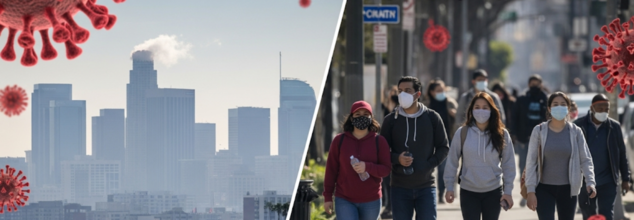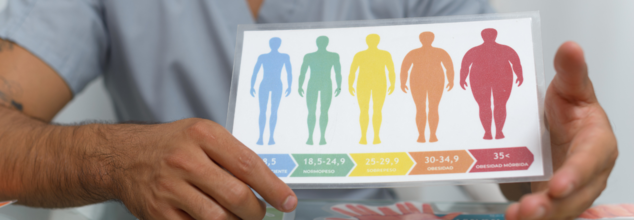- Health Conditions A-Z
- Health & Wellness
- Nutrition
- Fitness
- Health News
- Ayurveda
- Videos
- Medicine A-Z
- Parenting
- Web Stories
COVID-19 Rising Again In US But CDC Confirms Only 'Low' Activity—Why California’s Spike Warrants Attention?

Credits: Health and me
After months of steady decline, COVID-19 cases in the U.S. have begun to rise again—and no, it’s not an anomaly. This marks the anticipated beginning of a summer surge, with public health data underscoring how the virus behaves with seasonal rhythms—even while national activity levels remain low.
The Centers for Disease Control and Prevention now reports that infections are climbing in approximately half of all states, particularly throughout the Southeast, South, and the West Coast—California included. CDC’s national wastewater surveillance, which gauges virus circulation in sewage, has shifted from “very low” to “medium” activity, confirming increasing spread. In California, the WastewaterSCAN program showed the virus present at 95% of monitored sites, with concentration levels rising steadily since June.
While this escalation mirrors trends from previous summers, the data make it clear: COVID is here once again. California isn’t just another dot on the map—it’s a bellwether. With 150 COVID-related deaths per week across the U.S., even a modest surge in California can impact national outcomes. Moreover, its key role in travel, entertainment, and indoor-heavy lifestyles during heatwaves elevates the risk of amplification.
This is not a sharp spike, but a gradual climb, close to last year’s levels. That similarity should not breed complacency; rather, it offers an early chance to act.
The Rise of NB.1.8.1 (“Nimbus”) and Other Variants
Wastewater sequencing in California shows:
- LP.8.1 dominating with 33.2% of samples
- XFG at 24.6%
- NB.1.8.1, better known as “Nimbus” or the “razor‑blade throat” variant, accounting for 7.5%
Though nicknames highlight painful throat symptoms, there's no current evidence that Nimbus causes more severe illness or hospitalizations. Still, its growing prevalence and transmissibility mean health officials are tracking it closely.
CDC analysis reveals that COVID now follows a twice-yearly pattern—with surges in both summer (July–September) and winter (December–February)
San Francisco Chronicle. Researchers attribute this cycle to genetic changes in the virus’s spike protein, particularly the S1 region, which enhances viral binding and transmission.
History confirms this: California typically peaks in mid-July to late August—making current trends both expected and potentially warning signs of a broader wave.
Who’s at Risk and What You Can Do?
While activity levels are officially “low”, complacency isn’t wise—especially for high-risk groups: adults over 65, immunocompromised individuals, pregnant people, and infants under 2:
- Ensure vaccination within the past year or seek boosters
- Test if experiencing symptoms
- Wear masks in crowded or high-risk indoor spaces
As Dr. Peter Chin‑Hong of UCSF advises, “For those older than 65, very immunocompromised, pregnant persons and infants—especially under 2—I would make sure you have received a COVID vaccine at least in the past year.”
Emergency department visits for COVID remain low nationally, though recent upticks have occurred in the Pacific Northwest and Southeast—the highest since early spring. Notably, this summer rise coincides with a surge in Parvovirus B19, which poses risks for pregnant women and is prompting additional caution.
COVID hospitalizations have become more predictable with seasonal waves, but still linger above zero year-round, reinforcing the need for vigilance .
The recurring summer pattern suggests that COVID-19 is shifting from pandemic unpredictability to endemic regularity, but that doesn’t diminish its impact. Continued mutation, waning immunity, and seasonal behaviors (like travel and indoor gatherings) ensure that vigilance remains essential.
As the CDC and WHO emphasize, updating vaccines, using masks in crowded environments, testing when sick, and keeping track of local wastewater trends are practical steps everyone can take.
California’s rise in COVID cases—though still within low national activity—matters. It signals seasonal resurgence and underscores ongoing viral evolution through new variants like Nimbus. Protecting public health requires action: vaccination, testing, masking, and staying informed about evolving trends.
The summer wave is predictable—but entirely preventable in its impact. With timely measures, we can ride it out safely.
From ADHD To Burnout: Why Modern Life Is Making You Sleepless, Anxious And Insomniac

Credits: Canva
Your struggle to fall asleep, stay asleep, or wake up rested? It’s not just on you. And it never really has been. For centuries, sleep has been a fragile and complicated process. Historically, it took place in overcrowded, uncomfortable homes, alongside families, fire smoke, bugs, animals, and the unpredictable dangers of the night. In those times, people prayed for safety more than they prayed for dreams.
Fast forward to today — temperature-controlled bedrooms, memory foam mattresses, sleep masks, blackout curtains — and yet, millions are still wide awake at 3 AM, staring at the ceiling, wondering what’s broken.
It’s not just about your mattress or screen time. Your body isn’t failing you. It’s that the world you live in is making rest harder than it should be.
In 2020, over 14% of adults in the US reported struggling to fall asleep on most days, according to the National Health Interview Survey. About 12% have been diagnosed with chronic insomnia.
A third of American adults don’t get the recommended seven hours of sleep per night. And that lack of rest isn’t distributed equally: Native Hawaiian, Pacific Islander, and Black adults, along with those earning under $15,000 a year, are the most sleep-deprived.
What this really means is: sleep loss isn’t just a personal health issue. It’s a socioeconomic one.
You’re Not Lazy — The System Isn’t Built for Rest
We live in a society that glorifies hustle, devalues downtime, and equates sleep with laziness. We’re constantly connected, bombarded with notifications, and working longer hours — even when we're off the clock.
And then there's revenge bedtime procrastination — the habit of staying up late because it’s the only time you have for yourself. We scroll through emotionally charged or overstimulating content on our phones, even though we know it's sabotaging our sleep. We drink coffee too late. We binge-watch one more episode. We use alcohol to unwind, which only fragments sleep more.
Ironically, even the wellness-obsessed are losing sleep trying to perfect it — tracking every breath, wearing sleep rings, taping their mouths shut, and obsessing over micro-wakeups. Experts say this hyper-focus on sleep performance can actually heighten anxiety and worsen insomnia.
The truth is, many factors that destroy your sleep are beyond your control.
Shift workers — who make up 20% of the US labor force — have sleep cycles dictated by employers, not biology. Irregular schedules disrupt circadian rhythms and increase the risk of sleep disorders. Studies show that people of color are more likely to work alternating shifts, compounding their sleep challenges.
Lack of basic sleep-friendly infrastructure is another major barrier. People living in noisy, polluted, or unsafe neighborhoods — often low-income communities — face chronic sleep disruptions. Bright street lights, traffic noise, subpar housing, no access to air conditioning or heating — these all add up.
And then there’s the toll of racism and discrimination. Research shows that the stress from daily microaggressions and systemic injustice has a measurable impact on sleep quality and duration.
For many, sleep is not just elusive — it’s systematically denied.
Is Parenting and Caregiving Fuelling The Quiet Sleep Crisis?
Caregivers are among the most sleep-deprived populations. Babies, toddlers, aging parents — their needs don’t clock out at night. Sleep training might work for infants, but there's no such system for grown-up responsibilities.
If you're a new parent or a caregiver running on fumes, advice like “just wind down before bed” rings hollow. For people in this group, it’s not about willpower or habits — it's about survival.
Now add neurodivergence to the mix. A new study in BMJ Mental Health finds that adults with higher ADHD traits are significantly more likely to report insomnia, low sleep quality, and — unsurprisingly — a lower quality of life.
The research suggests that insomnia may be the link between ADHD symptoms and reduced life satisfaction. And while ADHD and insomnia both independently affect mood and functioning, their overlap is a major red flag.
The traditional treatment for one often ignores the other. Experts now advocate for targeted sleep therapies like Cognitive Behavioral Therapy for Insomnia (CBT-I) or Sleep Restriction Therapy to improve both sleep and daily functioning in adults with ADHD traits.
How Can You Sleep Better?
First, stop blaming yourself. Instead of focusing solely on sleep hygiene tips like cool rooms and no screens, try identifying what’s really keeping you up. Is it your work schedule? Your housing situation? Noise? Anxiety? All of the above?
If possible, consult a sleep medicine specialist to rule out disorders like insomnia, apnea, or circadian rhythm disruptions. If therapy is an option, CBT-I has proven effective for many.
For those dealing with unavoidable stressors — think shift work, noisy neighborhoods, caring for kids — small tools may help. White noise machines, blackout curtains, cooling fans, sleep earplugs. They’re not perfect, but they can create small windows of peace.
The goal isn’t eight perfect hours. It’s about carving out enough restorative rest — wherever and however possible — to function and feel human.
Sleep isn’t optional. It’s biological. Your body wants to rest. Your brain needs it. And even though society isn’t built to support that, the rhythm is still there — pulsing under the noise, waiting to be reclaimed.
So, maybe tonight, instead of battling the night like an enemy, trust your body. Dim the lights, breathe and let sleep come — if not easily, then at least without shame because the struggle to sleep isn’t yours alone.
Disclaimer: This article may include interpretations of research, and commentary that reflect individual or editorial perspectives. It is intended for informational purposes only and should not be considered a substitute for professional medical advice
BMI Calculators Cannot Predict Your Risk Of Death - Which Metric Can We Use?

(Credit-Canva)
Health is not linear for everyone. Many people have skewed perception about health; they think a person who is thin is naturally healthy, while a person who is overweight is inherently unhealthy.
A recent study published in the Annals of Family Medicine suggests that BMI, a measure of body fat based on height and weight, is a poor predictor of a person's risk of death. Instead, the study highlights body fat percentage (BF%) as a more effective and easily assessed measurement during routine checkups.
Shortcomings of BMI
Doctors have traditionally used BMI to check a person's fat, bone, and muscle health, especially since body composition is linked to a higher risk of conditions like type 2 diabetes and heart disease. BMI is calculated by dividing a person's weight by their height squared.
While a higher BMI can sometimes suggest a greater chance of developing certain health problems, there's growing evidence that it's an imperfect measure. It doesn't consider important factors like a person's age, biological sex, or how their fat and muscle are distributed.
For example, top athletes often have a lot of muscle, which can give them a high BMI. Even though these athletes are very healthy, focusing only on their BMI might incorrectly label them as having obesity.
On the other hand, some people with a "normal" BMI might still be at a higher risk for conditions like diabetes, high blood pressure, and fatty liver disease. These individuals are sometimes referred to as having "normal weight obesity" or, in simpler terms, being "skinny fat."
Why Body Fat Percentage Might Be Superior
With the limitations of BMI in mind, researchers looked into how strongly BMI is connected to the risk of death. They also wanted to see if body fat percentage, which they described as "an easy, reliable, and inexpensive measure," could do a better job of predicting this risk.
The research team analyzed health information from thousands of adults. This data included height, weight, waist size, and body fat percentage. They calculated BMI for these individuals and then tracked who passed away over many years. After considering various factors, the scientists made some key discoveries:
There was no significant link between having a BMI categorized as obese (meaning a BMI of 25 or higher) and a greater risk of dying from any cause when compared to those with a "healthy" BMI.
Body fat percentage, however, provided clear insights into mortality risk. Individuals with a high body fat percentage (27% or more for men and 44% or more for women) were significantly more likely to die from any cause.
Waist size was less accurate than body fat percentage but still showed some connection to a higher risk of death.
The Future of Health Assessments
The study suggests that directly measuring body fat percentage, which is relatively inexpensive and easy to do in a doctor's office, is better at predicting future mortality risk than using BMI.
This doesn't mean doctors should stop using BMI entirely. It can still be a simple starting point to help determine if a patient needs to lose weight or gain muscle to prevent chronic diseases. But it should be seen as just that—"an easy first step."
Ideally, other measurements should also be taken. The more information doctors have—including BMI, waist size, body fat, blood pressure, and cholesterol—the more complete a picture they'll have of a patient's health. Modern devices can measure body fat percentage quickly, often in under a minute. It's hoped that more doctors will start using body fat percentage measurements, as a direct measure of body fat can be a valuable tool for preventing disease.
Physician Associates Or Assistant Doctors? Government Review Urges Renaming To Avoid Misunderstandings

(Credit-Canva)
A recent independent review suggests that staff who help doctors in hospitals and GP offices, who are called Physician Associates (PAs) and Anaesthesia Associates (AAs), should be renamed "assistants." The review that has been in work since the past year has finally presented its findings and results. The Leng review has been looking into the various aspects of AAs and PAs to understand where there are shortcomings and why must there be changes.
One of the biggest issues that people have with PAs and AAs is confusing them with doctors. The review also recommends that these assistants wear specific uniforms and badges to clearly tell them apart from doctors. Crucially, it states that these assistants should not be the ones to diagnose patients' illnesses.
The UK Department of Health & Social Care called for this review last year due to ongoing debates about the exact roles and duties of these healthcare professionals. When PAs and AAs were first brought into the NHS in the early 2000s, there wasn't a clear plan for how they would fit into existing medical teams. This led to a lot of confusion about what they were supposed to do. Sometimes, when there weren't enough doctors, PAs filled in, even without the extensive training doctors receive, and without proper guidance from supervisors.
The report gives a full picture of the role of Medical Associate Professionals (MAPs) in UK healthcare.
Tragic Cases Highlight Confusion
The review heard from families who lost loved ones after they were treated by PAs, mistakenly believing they were qualified doctors. For example, a young woman died from a blood clot after being seen twice by a Physician Associate who thought her calf pain was just a sprain.
Another family shared how their elderly mother died from an infection after a PA treated her in hospital. While these families do not blame the assistants, they stress the need for much clearer identification and roles. They believe that in stressful hospital situations, patients and families might not fully grasp who is treating them.
Scrutiny And Problems Faced By MAPs
However, the College of Medical Associate Professionals also present the value of MAPs and how the public views them needs to get better. News and social media have sometimes created misunderstandings about what MAPs do and how they fit into healthcare teams. Patients sometimes get confused, thinking a PA is a doctor, even when efforts are made to explain the role. There's a need for clear public education campaigns to help people understand and accept MAPs in the NHS.
The report also highlights that MAPs are facing significant stress and negative feelings because of the current environment, which many call an "anti-MAP campaign." This negativity affects their mental health both at work and at home. They point to media stories, social media attacks, and strict new rules as major causes of distress.
Worryingly, bullying and harassment at work are common. Over a third of qualified MAPs reported being bullied, and many experienced online harassments. A large number of student MAPs also faced bullying during their training. These experiences have led many MAPs to consider leaving their jobs or actually leaving. Women MAPs and those from minority ethnic backgrounds were more affected, making up a larger share of those who left their jobs despite being a smaller group overall in the workforce.
The British Medical Association responds to the review highlighted that the report reveals how NHS England allowed these new roles to grow without properly checking if they were safe. They point to a lack of strong national leadership, no clear accountability, and a failure to listen to concerns raised by doctors, patients, and even coroners (who investigate deaths).
The BMA argues that allowing the roles of doctors and non-doctors to become unclear, even with the help of the General Medical Council (GMC), has been a serious problem. Many doctors, they say, will feel that their earlier warnings were justified.
Key Steps Taken to Improve Medical Assistant Roles
While the proposed name change is a positive step, many in the medical community believe more needs to be done to clearly define what these assistants can and cannot do to ensure safe teamwork in the NHS.
This report makes several important recommendations for Medical Associate Professionals (MAPs), like Physician Associates (PAs) and Anaesthesia Associates (AAs), to make their roles clearer and more effective.
Clearer Rules and More Power
The report strongly suggests creating official rules and standards for MAPs. This will help make sure they are held accountable and that the public trusts them more. Since new rules are already being put in place, this should bring more trust and stability to their roles.
It also recommends giving MAPs the ability to prescribe medicine and order certain X-rays. This change would allow them to do their jobs more efficiently and use their skills better. There should also be national standards for their training after they qualify and for how they can move up in their careers. This will ensure that MAPs across the country receive consistent training and development.
Better Teamwork and Support
The report advises putting more money into planning the healthcare workforce. This will allow for the smart growth of MAP roles, making sure there are enough of them to meet the needs of the NHS. MAPs can actually help improve the training of junior doctors, rather than hindering it.
Better teamwork and strong leadership will help MAPs fit in well, creating a unified healthcare team that benefits both medical staff and patients. The report also suggests doing regular checks using anonymous feedback from patients to keep track of how MAPs are performing and their overall impact.
Supporting MAPs' Well-being
Finally, the report highlights that the well-being of MAPs is a widespread issue within the healthcare system, not just about individual toughness. The rules set by medical groups must be made with the input of MAP leaders and checked carefully to ensure they don't unfairly exclude anyone. Feeling respected and safe at work is extremely important for keeping staff, ensuring patients are safe, and providing good care.
© 2024 Bennett, Coleman & Company Limited

